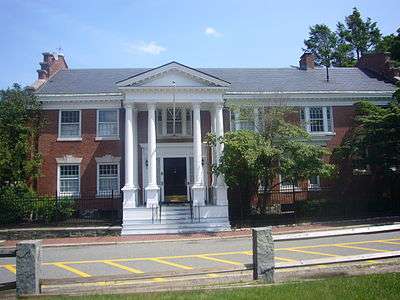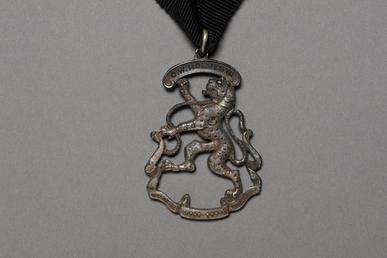Fly Club

The Fly Club is a final club, traditionally "punching" (inviting to stand for election) male undergraduates of Harvard College during their sophomore or junior year. Undergraduate and graduate members participate in club activities.
Founded 1836 as a literary society by the editors of Harvardiana, the club was granted a charter by the Alpha Delta Phi fraternity in 1837 and remained a chapter until surrendering its charter in 1865. With the graduation of the members of the class of 1868, the club was discontinued until 1878, when graduate members, including Edward Everett Hale (class of 1839) and Phillips Brooks (class of 1855), initiated undergraduates from the class of 1879, to whom the old charter was restored. In 1906, the charter was once again surrendered, and in 1910, the organization officially adopted the name "Fly Club," its unofficial title since 1885. In 1996, the Fly Club merged with the DU Club, another final club, and the combined entity retained the name "Fly Club."
Some sources maintain that the club's name was derived by combining the PH from "Alpha," the l from "Delta," and the i from "Phi," to get "Phli," pronounced "Fly".[1]
The club motto, suggested by Prof. Morris H. Morgan (class of 1881) and adopted Feb. 1902, reads DURATURIS HAUD DURIS VINCULIS, an ablative absolute construction translated as "Bonds should be lasting, not chafing or hard."
Two Holyoke Place
Constructed in 1896, with brick facade added in 1902, the Fly clubhouse is located at Two Holyoke Place, near Harvard Square, along the "Gold Coast" of formerly private residences that now comprise Harvard's Adams House (completed 1932)[2] The Fly sits in front of Harvard's Lowell House (1930), across Mt. Auburn St. from the Harvard Lampoon building (1909).
Fly Club Gate
The Fly Club Gate is located along the exterior of Winthrop House. An English Baroque structure, the gate was built in 1914 by a grant from members of the Fly Club. The Fly's symbol, a "leopard rampant guardant" (known as the "Kitty"), is centered within the ironwork above the entry. Inscribed below is a dedication: "For Friendships Made in College the Fly Club in Gratitude has Built this Gate."[3]
Notable members

ACADEMIA
- James Bryant Conant* - 26th President of Harvard University[4]
- Abbott Lawrence Lowell - historian, 25th President of Harvard University[5]
- Charles William Eliot - 24th President of Harvard University[6]
- Archibald Cary Coolidge - historian, Harvard professor, first director of the Harvard University Library[6]
PUBLIC SERVICE
- Franklin Delano Roosevelt - 32nd President of the United States[7]
- Theodore Roosevelt - 26th President of the United States[6][7]
- Oliver Wendell Holmes, Jr. - Supreme Court Justice[6][7]
- Jay Rockefeller - U.S. Senator from West Virginia[8]
- James Roosevelt- son of Franklin Roosevelt, U.S. Congressman (CA)[9]
- Deval Patrick - 71st Governor of Massachusetts[10]
- William Weld - 68th Governor of Massachusetts[11]
- Tony Lake - President Bill Clinton's National Security Advisor[12]
- Jared Kushner - Senior White House Adviser[13] and head of the White House Office of American Innovation[14][15]
- Joseph Clark Grew - career diplomat, U.S. Ambassador to Japan 1932-1941[16][17]
- Charles Francis Adams III - skipper of America's Cup defender Resolute, 1920; inductee, America's Cup Hall of Fame; Secretary of the Navy, 1929-1932[6]
RELIGION
- Edward Everett Hale - author, historian, Unitarian minister, Chaplain to the U.S. Senate[6]
- Phillips Brooks - clergyman, author, lyricist[7]
THE ARTS
- James Russell Lowell - poet, critic, editor, and diplomat[7]
- Ernest Lawrence Thayer - author of "Casey at the Bat"[18]
- Owen Wister - American writer, "father" of western fiction[6][7]
- Robert Charles Benchley* - American humorist
- Evan Thomas - American journalist and author[19]
- Robert Carlock - writer, producer[20]
- Whit Stillman - writer, film director
- Frederick Hubbard Gwynne - stage, film, and television actor
- Francis Higginson Cabot - gardener, horticulturist, founder of the Garden Conservancy, creator of Stonecrop and Les Quatre Vents,[21] a founder of Harvard Krokodiloes
- Herbert Dudley Hale - son of Edward Everett Hale; noted Boston and NYC architect, architect of the Fly's clubhouse at Two Holyoke Place.[22][23][7]
FINANCE and BUSINESS
- Albert Hamilton Gordon* - Wall Street entrepreneur, Chairman of Kidder Peabody
- David Rockefeller* - American banker [24]
- Louis Kane* - founder of Au Bon Pain bakery and café[25]
- Charlie Cheever - co founder of Quora
OTHER
- Lionel de Jersey Harvard* - first [collateral] descendant of John Harvard to attend Harvard College[26]
* Initiated into the D.U. Club, which merged with the Fly Club in 1996.
References
- ↑ Shand-Tucci, Douglass (2001). Harvard University. Princeton University Press. ISBN 1-56898-280-1. p. 101
- ↑ Cambridge Historical Commission, "City of Cambridge, Landmarks and Other Protected Properties" Archived 2010-06-05 at the Wayback Machine., 2009.
- ↑ "The Architecture" Archived 2016-11-09 at the Wayback Machine., Winthrop House (Facilities & History)
- ↑ "Facts on Final Clubs", The Harvard Crimson, March 3, 1999
- ↑ Yeomans, Henry (1977). Abbott Lawrence Lowell. Arno Press. ISBN 0-405-10009-4. p.38. "He tried to avoid what he considered Wilson's mistake in alienating them at Princeton; and he himself accepted honorary membership in the Fly in 1904."
- 1 2 3 4 5 6 7 Catalogue of the Alpha Delta Phi Club of Harvard University, 1836-1902. Cambridge, Mass. Harvard University Press, 1902.
- 1 2 3 4 5 6 7 Catalogue of the Fly Club of Harvard University, 1836-1911. Camb. (Mass.): The University Press, 1911
- ↑ "Harvard Journal: All-Male Club Opens Its Doors Warily," New York Times 9 October 1993. LexisNexis Academic.
- ↑ FDR Library, biography of James Roosevelt : "He was a member of the Signet Society, the Fly Club, Institute of 1770 and Hasty Pudding Club"
- ↑ "Patrick says he quit The Fly Club in 1983". The Boston Globe. 2006-08-03.
- ↑ Edlich, Alexander R (1993): Harvard 'final club' to may become first to admit women, The Dartmouth Online, October 19, 1993 : "According to The Crimson, Massachusetts Governor William Weld, who graduated from Harvard and was a member of the Fly Club, wrote the club in 1987 urging it to admit women."
- ↑ name="FACTSONFINALCLUBS1999"
- ↑ "Jared Kushner, Trump's Son-in-Law, Is Cleared to Serve as Adviser", New York Times, January, 21, 2017
- ↑ http://www.whitehouse.gov/the-press-office/2017/03/27/presidential-memorandum-white-house-office-american-innovation
- ↑
- ↑ "[Grew] was critical of Berlin society as being too rank-conscious, preferring Vienna society where admission to the inner circle depended on personal merit alone. This had been his reason for favoring the Fly Club at Harvard." Heinrichs, Waldo H., Jr. American Ambassador : Joseph C. Grew and the Development of the United States Diplomatic Tradition. Oxford University Press, 1986.
- ↑ "Grew, having been interned, left Japan June 25, 1942."
- ↑ Gardner, Martin (1995). The Annotated Casey at the Bat: A Collection of Ballads about the Mighty Casey/Third, Revised Edition. Courier Dover Publications. ISBN 0-486-28598-7. p.1
- ↑ "But one prominent alum, Evan Thomas, who is the Washington bureau chief for Newsweek magazine, said that his informal polling of fellow alumni showed strong support for a co-ed Fly." Rimer, Sara. "Harvard Journal; All-Male Club Opens Its Door Warily." New York Times, October 9, 1993.
- ↑ "The Fly Flees From Progress". The Harvard Crimson. 1994-10-04.
- ↑ "Francis H. Cabot, 86, Dies; Created Notable Gardens," New York Times, Nov. 27, 2011
- ↑ https://babel.hathitrust.org/cgi/pt?id=nyp.33433076012008;view=1up;seq=50
- ↑ https://www.newspapers.com/clip/3770881/noted_architect_is_deadherbert_dudley/
- ↑ Rockefeller (David) Papers, Rockefeller Archive Center, p. 19.
- ↑ "The Final Club Scene", Harvard Magazine, May 1997. "...says former D.U. graduate president Louis Kane '53..."
- ↑